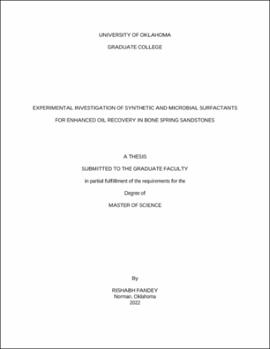| dc.description.abstract | Surfactants have been used to increase hydrocarbon recovery to meet the increasing demand for oil and gas. This mechanism of using surfactants reduces the Interfacial Tension (IFT) at the fluid/fluid interface and wettability at the rock/fluid interface to mobilize trapped oil out of the pores. However, there are two main limitations of the surfactant flooding process—first, high reservoir temperature & salinity, and second, adsorption of surfactants on the rock surface. Surfactant adsorption alters wettability of reservoir rock from oil-wet to water-wet. However, excess adsorption may decrease oil recovery, especially in conventional reservoirs with high temperature and Total Dissolved Solids (TDS). This study tested two synthetic amphoteric surfactants, one nonionic biosurfactant, and a base case with produced brine to understand wettability, IFT, surfactant adsorption, and its effect on oil recovery in Bone Spring sandstone formation. Produced brine has a high TDS of 237,705 ppm, and test conditions were kept at 145oF and 500 psi pressure. First, surfactant stability tests and CMC measurements were performed on three surfactants. Then, IFT measurements were performed between crude oil and surfactant solutions along with produced brine. Next, wettability alteration was studied by measuring contact angle on oil saturated rock samples before and after being exposed with surfactants and produced brine. Then, surfactant adsorption experiments were performed using UV-Vis spectrophotometer to calculate the amount of surfactant getting adsorbed on the rock samples. Lastly, surfactants and brine imbibition experiments were performed on plug samples, and oil recovery was quantified using 12MHz Nuclear Magnetic Resonance (NMR) spectrometer. All the recovery experiments were repeated on the same three plug samples with approximately 30 wt.% clay. This study shows that all three surfactants reduced IFT and altered wettability, but biosurfactant showed low IFT, much lower surfactant adsorption, and made the sample most water wet as compared to amphoteric surfactants. Imbibition experiments showed that biosurfactant have the highest oil recovery, while amphoteric surfactants have oil recovery even lower than produced brine. This study shows that surfactant adsorption affects oil recovery, which leads to loss of surfactants from solution to the rock surface. Measurements also show that the adsorption of amphoteric surfactants increases with increased clay concentration which shows the efficacy of surfactants depends on rock mineral composition. This study suggests that biosurfactants with glycolipids can be used in shaly sandstones at high TDS and temperature. With oil recovery using biosurfactants being very close to produced brine, it might be more economical to use only produced brine with no surfactants. | en_US |

